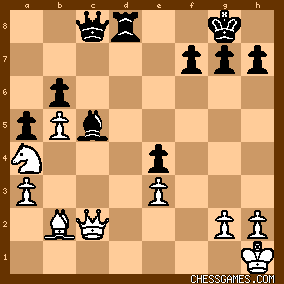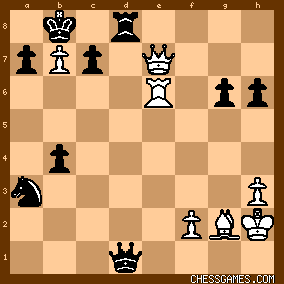|
< Earlier Kibitzing · PAGE 2 OF 2 ·
Later Kibitzing> |
| May-14-14 | | gofer: I suppose black has just given up a piece to Rxf5 or Rxc2, but either
way black is struggling and the back rank weakness that white has has
to be exploited to the fullest extreme to get back equality or more... 28 ... Rxc2
29 Qxc2 Qd7
Black threatens Qd1+ mating and Qxf5
30 g4
Suddenly black has nothing, so we need something similar, but not
quite the same...
<28 ... Rxc2>
<29 Qxc2 Qc8!>
Black threatens Qxc2 and Qxf5
<30 Rc5 Bxc5>

click for larger viewWhite is losing this at a canter, but black will take time to close this out... ~~~
Yep... |
|
| May-14-14 | | morfishine: 28...Rxc2 29.Qxc2 Qc8 30.Qf2 Qxf5 oops |
|
| May-14-14 | | patzer2: At the start of today's Wednesday puzzle, White's weak back rank and unprotected Rook allow Black to play 28...Rxc2! to clear the way for a winning double attack (Queen fork) after 29. Qxc2 Qc8!  . .In the final position, White must surrender decisive material or succumb to a back rank mate. |
|
| May-14-14 | | john barleycorn: Cannot wait any longer. So, here is the mandatory post with the mother of all exploitations of a weak backrang O Bernstein vs Capablanca, 1914
Agreed AJ? |
|
| May-14-14 | | therevolver17: 28..Rxc2 29. Qxc2 Qc8! (30.Qxc8 Rd1 with a mate to follow) 30. Qb1 (or 30.Qe2) Qxf5 |
|
| May-14-14 | | patzer2: < RedShield: After 24.Qd4?, White can be forgiven for not thinking about a weak back rank. The rest is a study in disillusionment.> Well 24. Qd4?! certainly overlooked much stronger possibilities in either 24. f6!  or 24. Qe2! or 24. Qe2!  , but the real losing moves were 25. Bxf5? and 26. Rxf5?? , but the real losing moves were 25. Bxf5? and 26. Rxf5?? Instead of 25. Bxh5?, 25. Bh5! Rad8 26. Qxb6 = holds the balance. Instead of 26. Rxf5??, 26. Qd2  concedes the loss of a pawn for practical OTB drawing chances. concedes the loss of a pawn for practical OTB drawing chances. P.S.: 24. f6!  is really complicated and might win, but I don't have enough computing power to confirm it with Fritz 12. Anyone willing to tackle it with a stronger program? is really complicated and might win, but I don't have enough computing power to confirm it with Fritz 12. Anyone willing to tackle it with a stronger program? |
|
May-14-14
 | | Sally Simpson: As 'Cheapo by the Dozen' states, the combination starts on move 24 
click for larger viewWith Black playing 24...Bxf5. Maybe they will post the same game on Friday starting from here. Hi John,
"...a weak backrang."
Super typo (or was it?) a back rank combo that rings a bell. |
|
| May-14-14 | | john barleycorn: <SallySimpson> :-).
You see, even my typo's are super. Like the whole guy. hahaha |
|
| May-14-14 | | TheBish: Novotelnov vs D Rovner, 1946 Black to play (28...?) "Medium/Easy", Black is down a piece for a pawn. This took me a little longer to solve than I think it should have. The reason is because the tough move to find for Black is not the 28th, but the 29th! What made the 29th move hard to see? Well, for one, it involves moving the queen to a square currently occupied by his own rook in the diagram (which you have to visualize as now being vacant), and secondly, it also involves offering a trade of queens, which is counterintuitive during an attack, or as the solution to a tactics exercise. 28...Rxc2 29. Qxc2 Qc8!
I had been staring at 29...Qd7 30. Rf1 Qxb5 (or Qd3), which fails to do anything as Black remains a piece down. But now Black wins at least a rook with this fork, combined with White's weak back rank and Black's well-guarded back rank (bishop on f8). (A) 30. Qxc8 Rd1+ 31. Rf1 Rxf1#.
(B) 30. Rf2 Qxc2 31. Rxc2 Rd1#.
(C) 30. Qf2 Qxf5! is one way to go (31. Qxf5 Rd1+ mates and if 31. Qe2 Qxb5! 32. Nc3 (32. Qxb5 Rd1+ or 32. Qc2 Qf1#) Qxe2 33. Nxe2 Rd2 will leave Black up a rook). But also winning is 30...Rd1+ 31. Qf1 Rxf1+ 32. Rxf1 Qc4 33. Rd1 Qxa4, leaving Black with queen for a rook. (D) 30. Qxe4 Rd1+ 31. Rf1 Rxf1#.
(E) 30. Qe2 Qxf5 31. Nc3 Qd7 appears to be White's best, but with Black being an exchange up and planning 32...Qd2 or 32...Qd3 it's not a contest. |
|
| May-14-14 | | gokusano: Too difficult a puzzle for me. I did not find the right 2 moves. Maybe my engine will. |
|
| May-14-14 | | Capacorn: So strange how some tactics just jump out at you. I've missed easier solutions than this one, but saw the answer here in about five seconds. I think it's because the combo in Bernstein-Capablanca, Moscow 1914, is so memorable to me. Any time I see a position with an even remotely similar idea, I seem to get it right away. Pattern recognition isn't all there is to chess, but it sure goes a long way! |
|
| May-14-14 | | kevin86: I saw 28...Qd7, I guess the answer was 29 Rf1. Right? |
|
| May-14-14 | | Chess Dad: <TheBish: What made the 29th move hard to see? Well, for one, it involves moving the queen to a square currently occupied by his own rook in the diagram (which you have to visualize as now being vacant), > Quite true. I got a similar puzzle about a month ago where the winning move was Qb4, leaving it en prise to either Qb3 or Rd4, but either one of those captures then allowed Rc1+ with mate next move. But, as you said, in that case the b4 square was unoccupied, and it made the visualization easier. |
|
| May-14-14 | | sombreronegro: To h2-h3 or h7-h6. To be controlling g4 or g5 with the rook pawn or not to be. But to that list of merits, also the escape square. Yes they can become juicy targets for bishop or knight sacs. A knight on g4 with an enemy queen and bishop on the d1-h6 diagonal sours my taste for it, but boy do I hate it when everything looks solid only to notice I have a back rank weakness, costing me the tempo I badly need to say nothing of finding out the hard way.... |
|
May-14-14
 | | FSR: It's only easy if you see it. I didn't - even though it was obvious that it must be some back-rank trick. |
|
May-14-14
 | | FSR: What a diabolical little combination. After the seductive 24.Qd4 ("centralization with a vengeance," as Fischer said; who could resist such a move?), White must have thought he was calling the shots. As <patzer2> pointed out, simply 24.f6! was much stronger, when Black, not White, would have been the one in trouble. 24...Bxf5! and the aftermath must have been a very rude awakening. |
|
May-14-14
 | | LIFE Master AJ: It took me around five minutes (maybe more, once more the old guy lost track of time) to get this one ... which was way too long, considering the simplicity of the problem. I THINK the correct answer is 28...RxR/c2!; 29.QxR/c2, Qc8!; (fork) and now if 30.Qf2, the back-rank weakness decides things ... (So now) 30...QxR/f5!; 31.QxQ/f5, Rd1+; and mates. |
|
| May-14-14 | | RedShield: It took me about five seconds, because I uploaded the game. |
|
| May-14-14 | | lost in space: Iw as going to play 28...Rxc2 29. Qxc2 Qd7 but I found 30. g4 and later 30. Rf1 in addition. It took me a white to find 29...Qc8!! |
|
| May-14-14 | | BOSTER: A weak back rank has diffrent appearance ,but the same beauty.
click for larger view
White to play. |
|
May-14-14
 | | keypusher: Took me a while -- I was trying to figure out a way to "fork" f5 and the back rank, and finally realized that ...Rxc2 clearing c8 for the queen was the way to go. Of course Rovner had to see it several moves before. |
|
| May-14-14 | | Patriot: Black is up a pawn for a piece.
28...Rxc2 29.Qxc2 Qc8 looks winning. Very tricky! |
|
| May-14-14 | | Pedro Fernandez: I didn't see 29...Qc8!! This kind of move in analogous situations is quite typical, but this time didn't come to my mind. 28...Rxc2 was obvious. |
|
| May-14-14 | | sycophante: <kevin86> I failed this one too. Here's the continuation I had in mind:
28... Qd7
29.Rf1 Qd3
30.Qxd3 exd3
31.Rd2 Rc2
32.Rxc2 dxc3
and then my brain got confused |
|
May-19-14
 | | LIFE Master AJ: 
click for larger view<Boster> The best I could come up with - without using an engine - is Rf6 Δ of Rf7 and/or Rf8. Am I missing anything? |
|
 |
|
< Earlier Kibitzing · PAGE 2 OF 2 ·
Later Kibitzing> |





